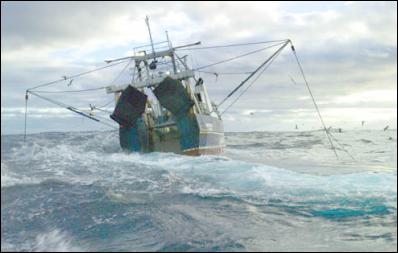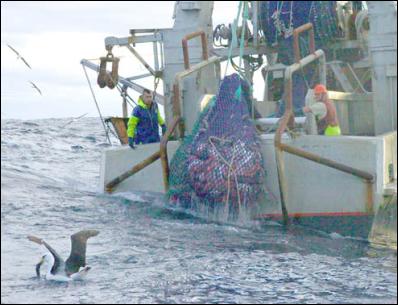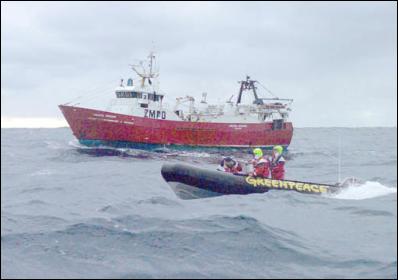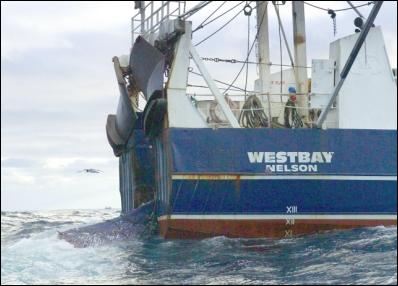Images: Greenpeace Locates Bottom Trawlers At Sea
High Seas: The role of the New Zealand bottom trawl industry on the high seas will come under close scrutiny in New York, after Greenpeace discovered three New Zealand bottom trawlers fishing on the high seas yesterday.
The Rainbow Warrior located the Amaltal Voyager, Westbay, and Corsair around 350 miles off the coast of New Zealand on the Northwest Challenger Plateau.

08 JUNE 2004 - TASMAN SEA - The NZ deep sea trawler West Bay does a fast turn after hauling its catch from international waters in the Tasman Sea. Greenpeace along with more than a thousand scientists are supporting the call for a moratorium on high seas bottom trawling, because of the vast amount of marine life that is destroyed by this fishing method. (C) Greenpeace/Roger Grace

08 JUNE 2004 - TASMAN SEA - The catch is hauled aboard the NZ deep sea trawler Corsair in international waters in the Tasman Sea. The red fish are orange roughy, and the rest is mostly bycatch to be discarded. A black browed mollymawk scoffs a fish it plucked from the net. Greenpeace along with more than a thousand scientists are supporting the call for a moratorium on high seas bottom trawling, because of the vast amount of marine life that is destroyed by this fishing method. (C) Greenpeace/Roger Grace

08 JUNE 2004 - TASMAN SEA - A Greenpeace inflatable watches as the NZ deep sea trawler Amaltal Voyager trawls in about 1000 metres of water in international waters in the Tasman Sea. Greenpeace along with more than a thousand scientists are supporting the call for a moratorium on high seas bottom trawling, because of the vast amount of marine life that is destroyed by this fishing method. (C) Greenpeace/Roger Grace

08 JUNE 2004 - TASMAN SEA - The NZ deep sea trawler West Bay hauls in its catch from the depths in international waters in the Tasman Sea. Greenpeace along with more than a thousand scientists are supporting the call for a moratorium on high seas bottom trawling, because of the vast amount of marine life that is destroyed by this fishing method. (C) Greenpeace/Roger Grace


 Gordon Campbell: On The Clash Between Auckland Airport And Air New Zealand
Gordon Campbell: On The Clash Between Auckland Airport And Air New Zealand Organics Aotearoa NZ: Gene Tech Bill - A High-Stakes Gamble That Risks Farmers’ Livelihoods, Trade, And NZ’s Global Reputation
Organics Aotearoa NZ: Gene Tech Bill - A High-Stakes Gamble That Risks Farmers’ Livelihoods, Trade, And NZ’s Global Reputation Fire and Emergency NZ: Check Your Smoke Alarms When Clocks Go Back This Sunday
Fire and Emergency NZ: Check Your Smoke Alarms When Clocks Go Back This Sunday NZ Government: Repeal Of 7AA Puts Child Wellbeing First
NZ Government: Repeal Of 7AA Puts Child Wellbeing First NZ Government: Reducing Ambiguity About What Is Reasonably Practicable For Health And Safety Compliance
NZ Government: Reducing Ambiguity About What Is Reasonably Practicable For Health And Safety Compliance Office of the Speaker: New Zealand Parliamentarians Attend 150th IPU Assembly
Office of the Speaker: New Zealand Parliamentarians Attend 150th IPU Assembly RNZRSA: RNZRSA Supports Willie Apiata VC's Stand To Drive Change To Veterans’ Support Act
RNZRSA: RNZRSA Supports Willie Apiata VC's Stand To Drive Change To Veterans’ Support Act


